Varicosis vessels are a common disease that develops in many adults.
According to statistics, this disease is more developed in women than men.Such veins appear in the legs and are more common with age.
In addition, the article records important facts about varicose veins, which is given appropriate photos to better understand how it looks and how it will be.
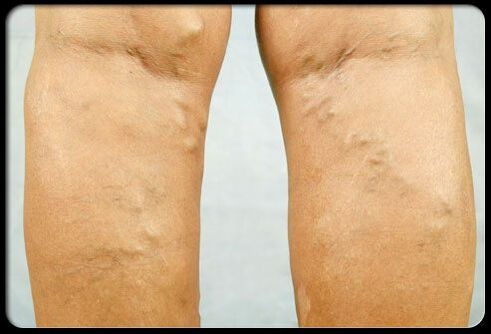
What are varicose veins?
Very expanded veins are abnormal expanded veins that grow in most legs.As a rule, like blue, purple or skin color.
They are stretched, wrapped and convex blood vessels that can rise above the skin surface.
What are the spider bottoms?
Aracular veins (as well as Telangectasia or vascular stars, vascular mesh), the collection of small blood vessels that grow near the surface of the skin.
Their frequent red, blue or purple, have a web view.Most vascular stars are found in face and feet.
What causes varicose veins?
Varicosis vessels caused by structural disorders in blood vessels.
The veins lead the back to the heart from different parts of the body.There are a number of one-sided valves to prevent reverse blood flow.
For a number of reasons, these valves can be damaged, which leads to the flow of blood inside the veins.The long stagnation increases the pressure inside the vein and weakens the wall of the blood vessel.
Then, the expansion of blood vessels and affected blood vessels, spiders and varicose veins are developing.
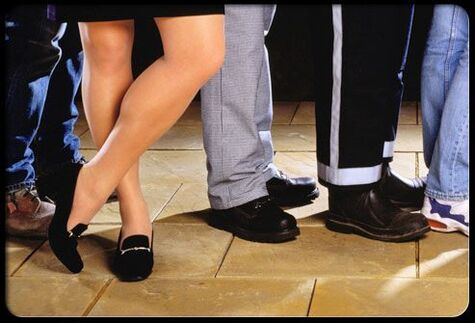
Reasons for development?
There are many different risk factors that increase human chances to develop varicose veins.
These include:
- old age
- Long standing or sitting,
- obesity,
- Pregnancy,
- Hormone therapy,
- Taking contraceptives,
- Injuries,
- Previous surgical interventions in the veins,
- Anamnes of thrombosis vessels,
- Family history.
Symptoms of varicose veins
Often there is no other symptom and sign of varicose veins except undesirable cosmetic types.However, some people can experience certain symptoms from varicose veins.
Symptoms may include:
- swelling,
- Sense of malfunction,
- This is a boring pain,
- burning,
- Itching,
- Violence,
- Tingling or convulsions in feet.
These symptoms often get worse after sitting or stopping.Individuals can also develop the brown skin color and the resulting trophic ulcers.
Varicosis complications of the veins
If you do not treat varicose veins, this may lead to:
- Trophic skin ulcers are developing.These open wounds appear in the legs, as a rule.Sometimes they can cause the development of soft tissue infection.
- Clouds of the veins are developing (surface thrombophlebiti).
- Bleeding from the veins is possible.
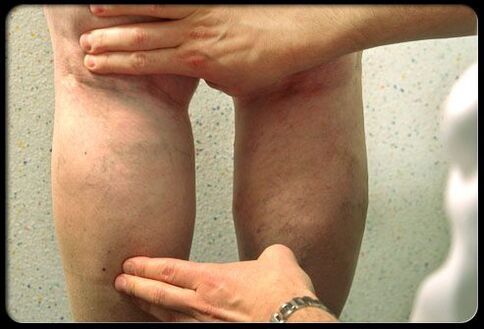
Diagnosis of vein mesh and varicose veins
Using a comprehensive examination of the affected area, you can diagnose the existence of varicose veins, which is one of the legs.
The exam consists of visual inspection and palpation of a problem area.Special attention is paid to the areas that change in redness, swelling, skin and trophical ulcers.
Treatment at home
Apparently, there are various methods that can be applied at home to help weaken some symptoms.These conservative methods can help prevent any potential complications.
Compression socks
Compression socks are a simple measure for treatment at home to alleviate the symptoms on the foot.
Improves blood circulation, increases the pressure on the foot.These socks are different types and compression strengths.Your doctor may recommend a pair suitable for you.As a rule, it is sold in pharmacies.
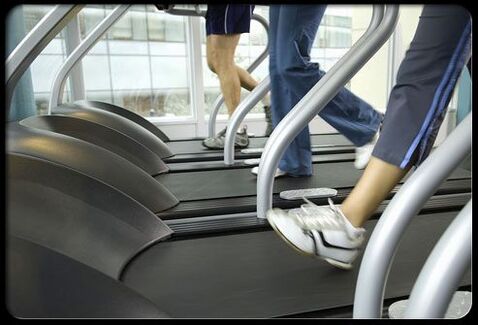
Change in lifestyle
Regular physical exercise and weight loss program can help light the signs of spiders and varicose veins.
Buried people should improve blood circulation and improve their feet and avoid lying on or sit down, while sitting to improve feet.
Sclerotherapy
Sometimes the conservative treatment of varicose veins in the house cannot give the desired result.In these cases, more specialized medical procedures can be carried out depending on the placement and size of abnormal veins.
These medical procedures are often carried out for cosmetic reasons.
Sclerotherapy is a common technique that can be carried out by a doctor;It is very effective in eliminating the majority of spider vessels and some varicose veins.
During this procedure that does not require anesthesia, the doctor presents a liquid solution directly inside the affected vascular and eventually causing the missing loss.A few sessions may need to get optimal results.Potential side effects include bruises, swelling, bleeding, infection and skin color change.
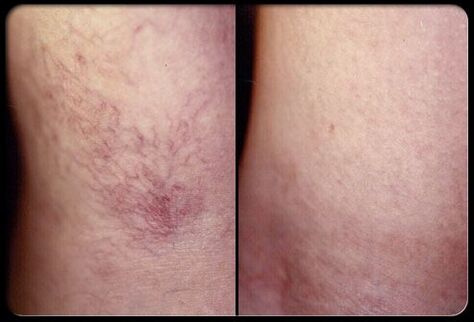
Sclerotherapy: before and after
The treatment with sclerotherapy may need several sessions and can change the time of healing depending on the person.
Basically, spider-shaped veins disappear within 3-6 weeks after treatment, can need varicose veins to improve for several months.
Laser treatment of varicose veins
Laser therapy is another alternative medical procedure that the doctor can be implemented.The results are sometimes used in addition to sclerotherapy to maximize.This technique is the most effective for aracnid and small varicose veins.
Laser therapy for patients who are not afraid of needles, although the doctor can inform you of what treatment is better in your special situation.
Laser therapy uses a bunch of bunches that heated the affected blood vessel, which is disappearing.
Potential side effects include light redness or tumors around the field of treatment, skin color, blisters and rarely scars.
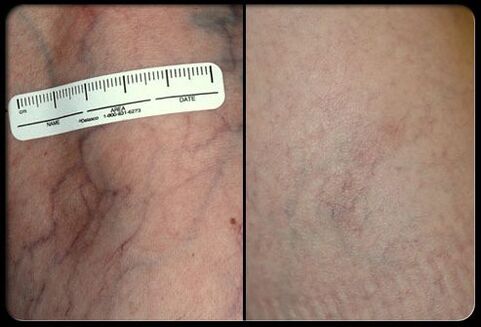
Laser therapy is a recently developed method for the treatment of varicose veins, which is treated with peans of various range light of the affected area.
Laser therapy: before and after the procedure
As with sclerotherapy, several sessions of laser therapy need a lot of time to achieve optimal results.After treatment, a few weeks can improve since a few months.
Surgical intervention in the veins
The operation is the choice of treatment for more severe cases of varicose veins.Your doctor will discuss with you the various surgery with you to decide whether the varicose veins are optimal for you.One of the surgical methods is the removal of vessels and their removal, through small cuts of leather.
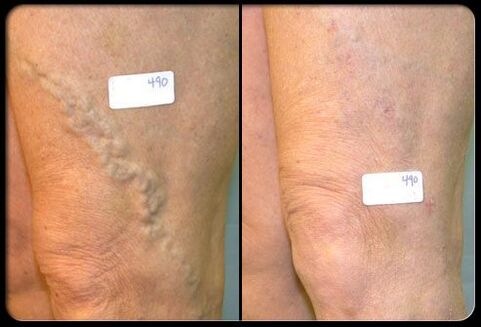
Operation in Vienna: before and after treatment
The work and removal of the veins often successfully eliminate the symptoms of varicose veins and cosmetic problems.This operation is carried out under the general anesthesia in the local, spine or medical institution.
The full recovery of this surgical intervention, as a rule, takes about 2-4 weeks.Potential complications, infection, bleeding, wounds, nerves, deep vascular thrombosis, adverse reactions to anesthesia.
Venade Laser Therapy
Venavenous laser therapy is a minimally invasive procedure in laser radiation, which consists of a laser radiation through a thin conductor that causes contraction.
Venavenoz laser therapy is characterized by 98% of the initial success.This procedure is carried out on an outpatient basis using local anesthesia or using soft sedation.
Patients were less clearly recovered faster with pain and intravenous laser therapy, and resumed faster compared to the removal of the veins.
Radio Frequency Ablasi
Intravenous Radio Frequency Ablasty is a minimally invasive procedure similar to venadic laser therapy.
Instead of using laser light, a catheter presented in the vein applies radio frequency energy that causes the affected ship's warming and contraction.
As in Intravenous laser therapy, patients are removed from surgical way compared to less intense pain and faster recovery, cleaning clothes and vessels.
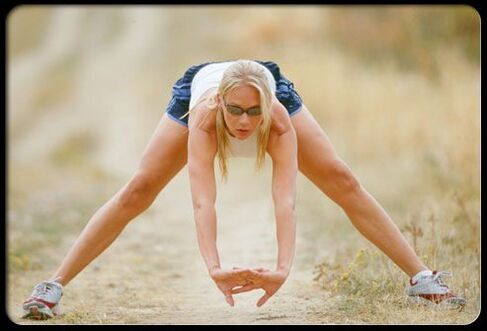
Prevention of varicose veins
If the varicose veins are not always possible, there are different methods you can do to reduce their chances of developing.
Preventive advice include:
- Regular physical exercise;
- Protect healthy weight;
- Avoid stretching sitting or stopping;
- Avoid removing your feet in a seating;
- Lift your feet higher while resting;
- Do not wear your body on the waist, groin and clutches.
Dear friends.The article is not a medical council and cannot serve as a doctor's consultation replacement.













































